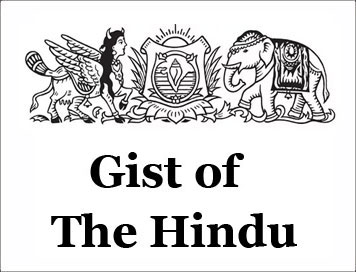(HOT) UPSC Current Affairs 2025 PDF
NEW! The Gist (NOV-2025) | E-BOOKS
Gist of The Hindu: JUNE 2023

Gist of The Hindu: JUNE 2023
The Hindu Current Affairs Week-1 (Free Available)
The Hindu Current Affairs Week-2 (Only For The Subscribed Members)
The Hindu Current Affairs Week-3 (Only For The Subscribed Members)
The Hindu Current Affairs Week-4 (Only For The Subscribed Members)
Kanger Valley National Park
- A rare Indian mouse deer or spotted Chevrotain was recently spotted in the Kanger Valley National Park in Chhattisgarh.
About Kanger Valley National Park:
- Location: It is located in Jagdalpur in Bastar district of Chhattisgarh state.
- The National Park derives its name from the Kanger River, which flows centrally from the Northwest to the Southeast direction.
- It got the status of a national park in the year 1982.
- Topography: It is noted for its highly heterogeneous land formations ranging from low flat and gentle areas to steep slopes, plateaus, valleys, and stream courses.
- It is home to three exceptional caves – famous for their amazing geological structures of Kutumbasar, Kailash and Dandak- Stellagmites and Stalactitees.
- National Park is known for the presence of underground limestone caves with dripstone and floston. The stalegmites and stalactite formation is still increasing.
- Tirathgarh Waterfall is located in Kanger Valley National Park.
- Vegetation: It is distinguished blend of mixed moist deciduous type of forests with the predominance of Sal, teak and bamboo.
Fauna:
- Major wild animals include tigers, mouse deer, leopards, wildcat, sambar, chital, barking deer, langurs, jackals, rhesus macaque, flying squirrel etc.
- The areal fauna at the park consists of common hill myna, red jungle fowl, spotted owlet, racket-tailed drongos, parrots etc.
Abohar wildlife sanctuary
- A recent blackbuck census by the Wildlife Institute of India stated that the blackbucks ‘are on the verge of extinction in Punjab.
About Abohar wildlife sanctuary:
- It is located in the state of Punjab.
- The entire area of Sanctuary is private or community-owned land of 13 Bishnoi villages.
- Flora: Albizia lebbeck, Acacia nilotica, Azadirachata indica, A. tortilis etc.
- Fauna: Wild Boar, Blue Fauna Bull, Porcupines, Hare, Jackal, etc.
Key facts about Blackbuck
- It is the sole extant member of the genus Antilope found in India.
- It lives mainly in open grasslands or dry deciduous forests.
- The antelope is native to and found mainly in India (with a small population in Nepal and Pakistan).
- It is widespread in the states of Rajasthan, Gujarat, Madhya Pradesh, Tamil Nadu, Odisha, and other areas throughout peninsular India.
- It has been declared as the state animal by the governments of Punjab, Haryana and Andhra Pradesh.
Conservation status:
- IUCN Red List: Least concerned.
- Wildlife Protection Act of 1972: Schedule I
- CITES: Appendix III
Tele-Law Programme
- Recently, The Ministry of Law informed that the Tele-Law programme achieved a new milestone with 40 lakh beneficiaries across the country empowered with pre-litigation advice.
About Tele-Law Programme:
- The Tele-Law programme comes under the Department of Justice, Ministry of Law and Justice and was launched in 2017.
- It is an e-interface mechanism to seek legal advice and consultation at a pre-litigation stage with the aim of ‘Reaching the Unreached’.
- The programme connects needy and marginalised people in need of legal aid with the Panel Lawyers via video conferencing/telephonic facilities available at Common Service Centres (CSCs) situated at the panchayat level. In addition, the service can also be accessed through the Tele-Law Mobile App.
- A Panel Lawyer is a practicing advocate selected by the Department of Justice and CSC-eGovernance Services or registered on the Panel of State /District Legal Services Authority.
Gongadi shawl
- Recently, Telangana’s woollen gongadi shawls has been refashioned into shoes for farmers by alumni of the National Institute of Design, Ahmedabad.
About:
- Gongadi, (known also as Kambal) is the traditional woolen blanket woven by the indigenous Kuruma pastoralist communities from wool of the indigenous Deccani sheep (known locally as Nalla gorrae) breed found in the Deccan Plateau region including the Indian state of Telangana.
- The famous blanket has once served the Indian Armed Forces to beat harsh winters at the borders.
Features:
- The unique gongadi is not only the symbol of rich diverse traditional weaving culture of the Deccan region but also the pride and identity of the local indigenous pastoralist communities.
- The coarse woolen blanket is famous for its durability and versatility.
- The tough gongadi usually lasts for more than a decade and acquires this unique quality from the craft of hand weaving.
- One of the unique natures of gongadi is that it does not fade but grows darker in time.
- The indigenous Kuruma weavers say that gongadi is so strong that you can lift a fully grown bull off the ground with it.
- The traditional gongadi is produced organically, without using any dyes either natural or synthetic. Sizing of the strings is done using the paste of soaked and cooked tamarind seeds.
CLICK HERE TO DOWNLOAD FULL PDF
This is Only Sample Material, To Get Full Materials Buy The Gist 1 Year Subscription - "Only PDF" Click Here
Click Here to Download More Free Sample Material
<<<Go Back To Main Page
Courtesy: The Hindu


